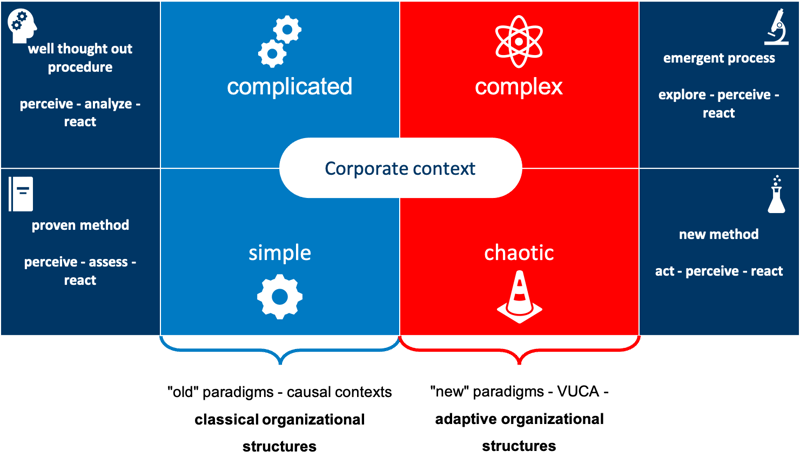Planning vs. experimentation - build... measure... learn...
What does the modern working world look like? How much planning is possible when the working world is spinning faster and faster and requires rapid responses from companies? In this note, we look at the trend shift from planning to experimentation.

Planning - in the beat of the rowing eight
Planning, by definition, is the process of setting goals and formulating methods, strategies and procedures to achieve them. Planning can refer to long-term or strategic planning as well as short-term or operational planning.
Traditional processes, for example in the automotive industry, show how enormously important detailed planning can be. Global supply chains, just-in-time delivery, automated production processes on the assembly floor, all require detailed planning. It can be said that the more standardized the process, the more automation and digitalization are involved, and the more stable the market environment, the more successful detailed planning is.
As a metaphor, we like to use the rowing eight. In calm waters and under controllable conditions, the boat covers a considerable distance in a short time. Predestined for top performance under standardized conditions. The team is perfectly attuned as long as the conditions do not change too much. Wind and waves, on the other hand, can be devastating - the eight gets out of sync and off course.
Experiment - white water rafting boat ride
Due to new competition on the market and constantly growing requirements on the customer side, planning is becoming more and more complex. To stay with the example of the automotive industry: there is virtually no standard car anymore. Today, cars can be configured like tailor-made suits and offer countless variants in terms of drive type, equipment and ambience.
Enabling this individualization within an automated assembly process implies increased complexity and requires additional effort in planning. In addition, external influences on the future of mobility are unsettling the entire industry.
If markets become more dynamic, conservative business models suddenly no longer work. Companies simply lack the time to plan things, because the fast pace of the markets not only creates pressure to act, but also numerous different options.
In their position paper, the German HR boards stated back in 2016 - and at four years ago, that feels like an eternity ago:
"The path of transformation leads primarily through experimentation.
Only with experiments can 'if-then chains' be tested."
What's more, experiments generate hard facts that help legitimize major investments in new approaches.
How useful an experimental, agile approach can be depends on the context. Experimental and agile are not always appropriate any more than standardized planning.
A simple model that clearly presents the different parameters is provided by the Cynefin framework.
Cynefin Framework
The knowledge management system "Cynefin" developed by the scientist Dave Snowden is helpful to classify framework conditions and to identify a suitable process. Whether a process should be linear, lean or agile depends on the simplicity, complexity or complexity of the task and challenge at hand.
To put it simply: the more complex the environmental conditions, the more likely it is that agile procedures can contribute to solving existing challenges - the simpler they are, the more likely it is that classic processes (waterfall, LEAN) will be applied.

Figure: Process selection and context conditions (i. A. Snowden, Cynefin model).
Agile processes are numerous and come in different forms. The best known is the Scrum method, which we have already described elsewhere. Here, we would like to focus on two other, meanwhile proven and successful approaches and illustrate each of them with a best practice example.
Design Thinking
Design Thinking is a customer-centric and iterative method for solving complex problems and developing new ideas. Design Thinking enables the development of a superior solution from the customer's point of view - under consideration of economic efficiency, feasibility and desirability.
This involves the creation of prototypes at an early stage. Insights gained are recapitulated. In order to obtain as many different perspectives as possible on a problem, various people with different experiences and backgrounds are involved in the process.
Best Practice AirBnB
In the early days, the founders of AirBnB had trouble figuring out why certain ads were successful and others were not. Using design thinking, they quickly found that unsuccessful ads had one thing in common: They had bad photos.
To solve this problem, they launched a photographer program - now very successful and famous - to help landlords with inviting photos.
This analysis and solution is portrayed as a "turnaround" in AirBnB history.
Minimum viable product
A Minimum Viable Product (MVP), literally a minimally viable product, is the first minimally functional iteration of a product that must be developed to meet customer, market or functional needs with minimal effort and ensure actionable feedback.
This concept has become well known as part of the Lean Startup method, which goes back to Eric Ries. The basic idea is that a good business idea can only produce successful products if customer requirements are consistently met and incorporated into the final product.
In this respect, a Minimum Viable Product is a simple prototype that must be further developed through customer feedback. The quickly and simply created product is only equipped with the absolutely necessary core functions. For example, for an internet-based product by a landing page to save work, money and time.
The MVP is published to gather timely feedback from potential customers; early adopters ("innovators"), who can best empathize with the product intent, play a special role. The feedback is used to expand and improve the MVP round by round.
Best Practice Dropbox
The world-renowned cloud storage giant Dropbox is a successful prime example of an MVP. In the beginning, the now top-selling company consisted of just an explainer video that conveyed the basic benefits of the product idea in an original way.
In the end, the video about Dropbox was so convincing that signups grew from an initial 5,000 to 75,000 overnight. And that was despite the fact that the actual software solution didn't even exist yet!
Conclusion:
Pandemic Year 2020 put it very clearly: we are in a rafting boat in a rip current. That sounds dramatic, but it is. Had it not been for gigantic government grants, the consequences of the pandemic would have already taken many more organizations with them. This is pure VUCA - new information every day, absolute control on sight in great uncertainty as to what the coming day will bring.
In such times, planning is only possible at short intervals. What can be regulated and routinized and always runs the same way can be described. Complex challenges, however, require creativity, flexible thinking and a step-by-step approach through experimentation.
Through early testing on the customer and a customer journey, for example with the help of design thinking or MVP, companies can decide faster and effectively advance innovations.
REFLECT offers various workshops on the topic of agile methods. With us, you are safely at the helm, no matter which fairway you are on. Feel free to contact us, we will advise you individually.
Literature:
atatech Implus (20.04.2016): Shaping the digital transformation - What HR directors say about the future of work. An opinion piece from the Human Resources Circle of atatech and the Jacobs Foundation, available at: Shaping the digital transformation - What HR directors say about the future of work. A mood picture from the Human Resources Circle of acatech and the Jacobs Foundation - acatech.
Eric Ries (2011). The Lean Startup. New York: Penguin Random House.
David J. Snowden & Mary E. Boone: A Leader's Framework for Decision Making. In: Harvard Business Review. November 2007, pp. 69-76 available at A Leader's Framework for Decision Making (hbr.org).

